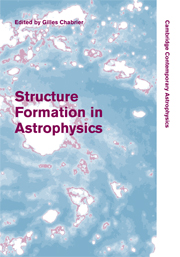Book contents
- Frontmatter
- Contents
- List of contributors
- Preface
- Part I Physical Processes and Numerical Methods Common to Structure Formations in Astrophysics
- Part II Structure and Star Formation in the Primordial Universe
- 6 New frontiers in cosmology and galaxy formation: challenges for the future
- 7 Galaxy formation physics
- 8 First stars: formation, evolution and feedback effects
- Part III Contemporary Star and Brown Dwarf Formation
- Part IV Protoplanetary Disks and Planet Formation
- Part V Summary
6 - New frontiers in cosmology and galaxy formation: challenges for the future
Published online by Cambridge University Press: 11 August 2009
- Frontmatter
- Contents
- List of contributors
- Preface
- Part I Physical Processes and Numerical Methods Common to Structure Formations in Astrophysics
- Part II Structure and Star Formation in the Primordial Universe
- 6 New frontiers in cosmology and galaxy formation: challenges for the future
- 7 Galaxy formation physics
- 8 First stars: formation, evolution and feedback effects
- Part III Contemporary Star and Brown Dwarf Formation
- Part IV Protoplanetary Disks and Planet Formation
- Part V Summary
Summary
Abstract
Cosmology faces three distinct challenges in the next decade. (i) The dark sector, both dark matter and dark energy, dominates the universe. Key questions include determining the nature of the dark matter and whether dark energy can be identified with, or if dynamical, replace, the cosmological constant. Nor, given the heated level of current debates about the nature of gravity and string theory, can one yet unreservedly accept that dark matter or the cosmological constant/dark energy actually exists. Improved observational probes are crucial in this regard. (ii) Galaxy formation was initiated at around the epoch of reionization: we need to understand how and when the universe was reionized, as well as to develop probes of what happened at earlier epochs. (iii) Our simple dark matter-driven picture of galaxy assembly is seemingly at odds with several observational results, including the presence of ultraluminous infrared galaxies (ULIRGS) at high redshift, the ‘downsizing’ signature whereby massive objects terminate their star formation prior to those of lower masses, chemical signatures of α-element ratios in early-type galaxies and suggestions that merging may not be important in defining the Hubble sequence. Any conclusions, however, are premature, given current uncertainties about possible hierarchy-inverting processes involved with feedback. Understanding the physical implications of these observational results in terms of a model of star formation in galaxies is a major challenge for theorists and refining the observational uncertainties is a major goal for observers.
- Type
- Chapter
- Information
- Structure Formation in Astrophysics , pp. 133 - 158Publisher: Cambridge University PressPrint publication year: 2009
- 2
- Cited by

